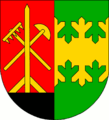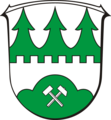Fir cut
In heraldry, the fir cut is a herald's image as a coat of arms, with which a coat of arms can be divided or split into two fields . Two different fir cuts are known in heraldic art and are not always clearly described in the blazon . The tincture is made according to the heraldic rules, green is preferred.
Fir rice cut
With this fir-cut variant, short, stylized fir branches are placed next to each other. With a good drawing of the coat of arms, an identical drawing is created in the free space of the branches in an inverted form, but with a different tincture, so that it results in a cut. This cut variant appeared in heraldry in Finland after 1949 and is also more widespread here. It is correctly referred to as fir rice cut .
in the fir rice cut split of silver and green ( Sideby , Kristinestad FI)
The coat of arms of the municipality of Laekvere , Estonia, split in the fir rice cut
split and cut in the fir rice cut in the coat of arms of Varpaisjärvi , Finland
The head of the shield in the coat of arms of Heinersdorf an der Tafelfichte separated by fir rice
Fir top cut
In the second variant, fir tree tops are also placed next to one another in their stylized form, thus creating a coat of arms. In the description, the cut is often emblazoned with a fir top cut or fir top cut. The height of the fir tops and the number of side branches is only important for a good coat of arms and is rarely considered in the description.
green-silver fir cut in the coat of arms of Burgwald
... above three green fir trees in the cut: Nentershausen (Hessen)
See also
literature
- Gert Oswald : Lexicon of Heraldry. Bibliographisches Institut, Leipzig 1984, p. 391.









